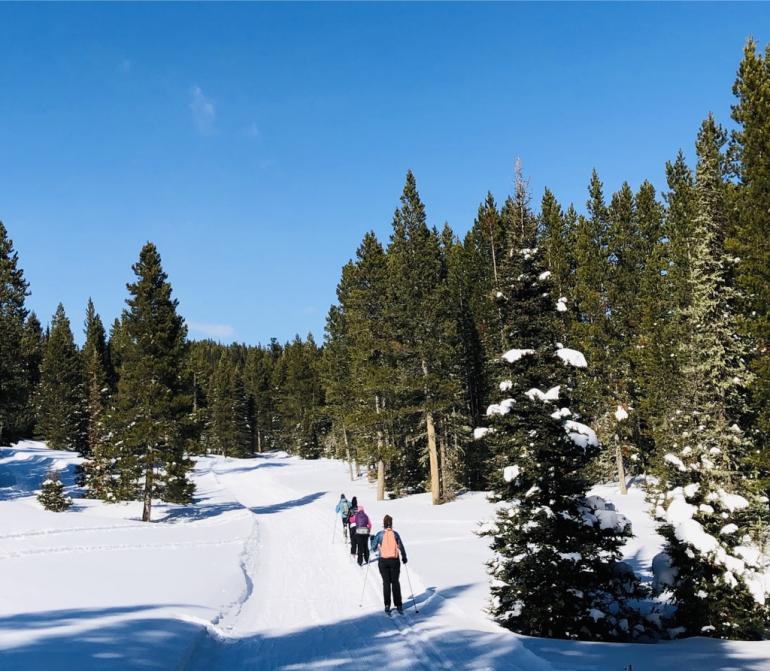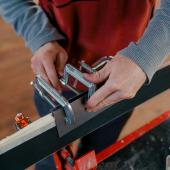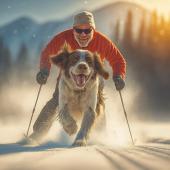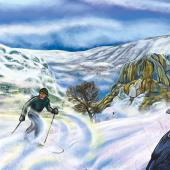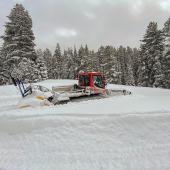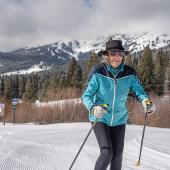Skinny Skis & Nominal Fees
At Bohart Ranch, there’s a point at the bottom of Psycho Pit when the groomed trail bends hard right. Only one pair of skinny tracks jumps the ruts, heading straight into the trees. I have chosen the path less traveled, though unfortunately “chosen” implies more of a conscious decision than is probably warranted. With my tips bent back somewhere past my ears and my hands locked in pole straps under the powder, I wait for the spring thaw.
How did I get talked into this skate skiing thing? An even better question: at what point did I become a fanatic, skiing through the dark trees with a headlamp? As I lose feeling in all non-essential body parts, I blame Bozeman.
The town has long been a skiing mecca—for most it means riding lifts for face-shots through the “cold smoke” of Big Sky or Bridger Bowl. However, in recent years Bozeman has reinvented itself as a national-caliber Nordic skiing destination. With the top male and female junior cross-country ski racers in the country, the U.S. #1-ranked Nordic facilities, and the 2002 Coach of the Year (a flying Macedonian named Dragan), Bozeman is leading the skate skiing revolution.
I had come to the sport through benign channels, having long ago paid my dues in wool knickers and three-pin bindings, but when I moved to Bozeman two years ago, something changed (my girlfriend would say “snapped”). As I toured leisurely through Lindley Park after work, groups of Bridger Ski Foundation teenagers blew past, looking like lycra’d flamingos while coach Dragan Danevski snapped at their heels yelling, “Hup, hup, hup!”
I started to get the itch. I switched from wool to a polypropylene underlayer, but the itch was still there.
Then came the Ski Swap—for $49 I was in business. The expert at the Swap even let me in on the real selling point of skate skiing: no kick wax! And to get into the swap early, I had signed up as a “Masters” member of the Bridger Ski Foundation. Big mistake. I would soon get the B.S.F. newsletter romanticizing various forms of winter masochism.
My vocabulary changed drastically in the next six months to include terms such as “V2 alternate”, “Spam Cup”, and “Special Blue”, and West Yellowstone was shortened to simply “West”. I found that “cross-country skiing” was now “Nordic”, and was split into skate and “diagonal”, with diagonal being the classic style many picture when they think of frostbite and lederhosen. Skate skiing is diagonal’s younger, meaner cousin, using the same back-and-forth pushing as one would use on ice skates or on the flats with alpine gear. My lung capacity increased in direct proportion to my pain tolerance.
My first efforts were as a Bohart weekender. Located 16 miles up Bridger Canyon Drive (just past Bridger Bowl), Bohart is the closest full-service Nordic ski area to Bozeman. The area offers rentals, lessons, and trails for all abilities, though with its unforgiving elevation profile, Bohart is best suited to those with some prior experience.
Season pass holders can huff through the beautifully maintained trails as soon as the snow will support it; day-trippers have to wait until the official opening date of December 1st—pay your $12 day fee at the obvious hut. A season pass ($160) also allows night access (if you’re into that sort of thing), during which time the pay-hut is closed. The easy-to-follow trail markers and maps placed strategically around the ranch make exploring Bohart simple. The site of the 2002 National Championships, Bohart also hosts various races during the season including the Sacajawea Ski Marathon (35K).
After watching me herringbone up the hills at Bohart and make deals with higher powers on the way down, Dave Pierce, co-chair of the Bridger Ski Foundation Nordic program had mercy (read: took pity) on me and recommended I check out West Yellowstone. Using the “it’s in the phone book” criteria for determining what is and isn’t local, West Yellowstone squeaks in at a beautiful hour-and-a-half drive from town.
On Thanksgiving weekend, the impeccably groomed trails of West host Fall Camp, one of the first major races of the year. While mortals are unlikely to compete with Bozeman locals Kristina Trygstaad-Saari or Leif Zimmerman (the country’s top male and female Nordic juniors), Fall Camp also offers a range of clinics for all abilities and more camaraderie than you can shake a carbon-fiber pole at.
After Fall Camp, West reverts to a sleepy local area. The only difference between post-camp West and other sleepy local areas is that West’s Rendezvous network remains one of the best groomed trail systems in the country. After self-registering at the trailhead ($3), enjoy miles of signed and groomed trails that cut through tight timber and rolling meadows. An evening ski comes alive with the sound of howling wolves as you slice silently through the snow. During weekdays, you are likely to make the only tracks other than the groomer.
In mid March, the town comes out of hibernation to host the West Yellowstone Rendezvous (50k, 25k, 5k, kids’ events), a race that is as friendly to tutus and bumblebee costumes as it is to sponsored athletes in superhero speed suits. Book your rooms in advance.
At some point every Bozeman skier has to visit Lone Mountain Ranch near Big Sky. Other than offering all that would be expected of the #1-ranked Nordic ski area in the country, the lodge has good pancakes, too. With 75 kilometers of posh trails, easy logistics, a beautiful setting, comprehensive rentals, instruction for any level, an on-site lodge, professional groomers, etc., Lone Mountain Ranch is THE place—but it doesn’t come cheap: $18 gets you through the gates; add another $18 if you need rentals. I went, I saw, I sweated, but the hefty $49 I had spent on gear at the Swap prohibited too many days at LMR.
It was late in my first season that I stumbled onto Bozeman’s great Nordic skiing secret: you don’t have to drive to one of the established areas in order to kick and glide to your heart’s content. In fact, standing at Montana Aleworks in downtown Bozeman (as one is wont to do from time to time), you are within a 10-minute drive of three groomed areas where the locals go after work to tune their technique and lubricate their lungs.
At Lindley Park, just across the street from Aleworks (hereafter referred to as Town Center), enjoy three connecting loops, each about the size of two football fields. On any given night (defined as later than 4:12 pm), locals light their headlamps, making the Lindley loops resemble a model train set. The park also hosts the “prestigious” Lindley Cup (local boasting rights), and the Ski in the New Year hullabaloo-extravaganza, both sponsored by the Bridger Ski Foundation. Access the trail system by parking on Highland (toward the hospital), rather than through the park gates off Main Street.
The most extensive local network of groomed trails is at the Bridger Creek Golf Course. From Town Center, head north on Rouse as if you were going to Bridger Bowl or Bohart. Just after the road bends right (1.4 miles from Main Street.) go left on Story Mill. Park near the golf course.
If it weren’t for groomers, you’d have to drop breadcrumbs—the Bridger Creek Golf Course system is deceptively large, with trails on either side of the road and across the footbridge to the north. Like paddling the Boundary Waters, what looks like an inlet is likely to access an entire new set of trails. Bring a lunch and explore, or time laps around the obvious loop; the view of the Bridgers on a clear winter day is reason enough to get out the boots and poles. As an added bonus, the Bridger Golf Course gets two paws up from my yellow lab, Gus, who appreciates the course’s pet-friendly policy and the sanctioned opportunity to run around and bite stuff (though he may have worn out his welcome last year—look for postings concerning the Bridger Creek pet policy).
The Riverside Golf Course also grooms for diagonal (classic) skiing. From Town Center, go north on 7th and cross I-90. Continue about two miles before taking a right on Springhill Road. The Riverside Golf Course is close, signed, and obvious.
Sneaking in before the big snows close canyon access, B.S.F. grooms Hyalite once in December near History Rock for the Hyalite Challenge. The area stays skate-able after the race until deteriorated by snows and use. As local race dates are subject to scheduling based on last-minute analysis of the Farmers Almanac, double-check dates at Bangtail Bike & Ski on Main Street before eating that big carbo-load dinner.
When exploring Bozeman’s groomed areas this season, look for tracks into the trees. If they don’t turn around soon at yellow snow, dig just below that first layer of powder and pull me out. I take a little dollop of brandy with my rescue hot chocolate.

